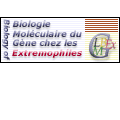The development of global approaches in biology has been not only fast, but has literally exploded in many directions,
so that there is a clear need of puting these different experiences in common. For instance, one of the first tasks when
a genome is sequenced is to try to extract relevant information from the nucleotide sequence. Besides the classical
algorithms to detect potential genes, new programs are developped, based on artificial intelligence and devoted to
identify, compare, classify gene products and to produce annotations of greater quality and good data bases. Parallel to
these advances, more fundamental research is aimed to better understand the linguistics of genomes and how they evolved,
to identify protein families, and to predict their enzymatic activities with good accuracy. Groups of Danchin (Paris),
Trifonov (Rehovot), Labedan (Orsay), Koonin (Bethesda), Fichant (Marseille) Allen (Lund, Sweden) Gascuel (Montpellier)
are particularly active in these domains and wish to participate in this school.
Beyond these analyses at the level of primary sequences, three-dimensional structures of gene products were
investigated at a large scale, compared and classified. New methodologies were developped to speed up these analyses, as
EM (Baumeister, Munnich), AFM (Marilley, Marseille), or large scale cristallography (Moras, Strasbourg, Janin, Orsay).
This global approach is designated as "Structural Genomics". Major developments of this field appear in the domain of
enzyme functions and mechanisms (Brenner, Berkeley), and application to Pharmacology and Toxicology (Hol, Seattle,
Grenet, Basel). Another growing field concerns Structural Genomics of RNA (Michel, Gif).
At the time sequences and structures are determined in a large scale, Genome-wide gene expression studies are
undertaken, both at the stage of transcription (transcriptome) and of protein products (proteome).
In the first approach, the level of transcription of large sets of genes, sometimes the whole genome content, is
measured, using a variety of classical or new methodologies, as micro-arrays, DNA chips, SAGE, two hybrid... The results
must be analyzed and classified. This approach is often designated as "Functional Genomics", and has been extensively
applied to micro-organisms (yeast), plants (Arabidopsis), and now to the development of animals (nematode, insects).
Groups of Goffeau (Louvain), Dujon (Paris), Bolotin-Fukuhara (Orsay) Oliver (Manchester), Dutreix (Orsay), Werner (CEA,
Saclay), Van de Sande (York), Plasterk (Utrecht), are particularly active in the domain, and wish to participate in the
school.
In the second approach called Proteomics, people try to analyse the whole protein content of an organism, and , in
some cases, their mutual interactions. Again, new methodologies, as 2D maps, mass spectrometry, protein microarrays, two
hybrid systems are developped that merit to be described in this school. Groups of Legrain (Paris), Rabilloud
(Grenoble), Dujon (Paris), Séraphin (Gif), Werner (CEA, Saclay) are deeply involved in these developments.
Applications of proteomics to drug design are again evident (Hol, Seattle, Grenet, Bâle). Integration of these different
levels of analyse, enzyme content, gene expression, metabolism will give an accurate picture of the physiology of an
organism (Plasterk, Utrecht).
A particular mention will be made to Human Genomics, with the technical problems of mapping large genomes, the
overview of the gene content and of the expressed genes, and the vast domain of genetic deseases. Groups of Weissenbach
(Genoscope, Evry) , Munnich (Paris), Demaille (Montpellier), Avner (Paris) and others have been contacted to give a
general update of this domain, including discussions on ethical problems (Fagot-Largeaud, Paris).
Another important domain where genomics is promising concerns micro-organisms, for which the small size of the
genomes allows to accumulate complete sequences of a large number of organisms. Hundreds of these genomes will be
available in a near future, allowing to perform multi-genome comparisons (Dujon, Paris). The benefit will be
inestimable, both in terms of fundamental knowledge on the structure, variability, evolution, functionning of a genome,
but also in terms of economical importance and human health, through investigations on microbial pathogens (Weinstock,
Huston, Rappuoli, Siena). A particular attention in the school will be made on the world of extremophiles, especially
archaebacteria, for their adaptation, evolution, and for their important content of eukaryotic-type genes. Groups of
Forterre and Duguet (Orsay) are active in this domain.
Finally, phylogenic aspects of genomics will be treated in the program of the school, with emphasis on methodologies
to construct phylogenic trees (Philippe, Paris) and on the connections between molecular evolution and geological
changes (Hedges, Pensylvania).
|

















